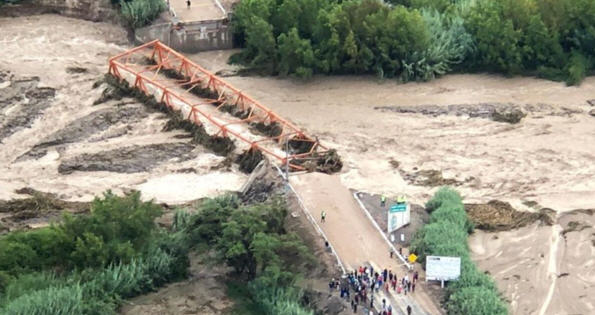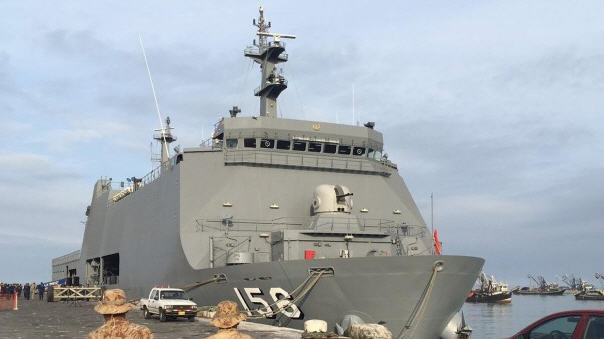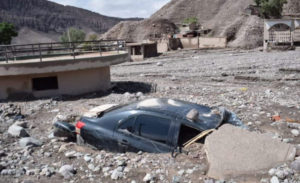
Flash floods and landslides have killed at least 16 people over the past week, with damage to infrastructure and crops in the southern regions of Moquegua, Tacna and Arequipa as well as in the northern highlands of Piura. Two of the people were killed by rocks in a landslide in Yauyos, in the southern highlands of Lima.
According to weather scientists, the last time rains in Moquegua, Tacna and Arequipa were as heavy was in 1957 — Tacna, with a usual annual rainfall of 230 liters per square meter, reported 120 lt/m2 just over the past 10 days.
The Civil Defense institute, INDECI, reports that 8,000 people have been affected so far (injuries, damaged or destroyed homes), that 15 bridges have been destroyed and more than 150 kms of roads and highways have been damaged

President Martin Vizcarra declared a state of emergency in several provinces in the south, and Premier Cesar Villanueva and the 18 ministers in his Cabinet have been each assigned a specific region in the country for oversight and aid. The Air Force has flown aid and medical teams to several destinations in the south, and the Navy’s new multipurpose ship, the Pisco, sailed to Ilo with 500 tons of humanitarian aid as well as heavy equipment, including earthmoving machinery.
The rainy season is heavy again this year due to the El Niño weather phenomenon, and the weather bureau — Senamhi— has issued warnings that rains are expected to be heavy on the north coast over the next two weeks, as well as in the northeast rainforest. Some areas have emergency plans in place but reconstruction in northern Peru has been slow after the damages in the 2016-2017 season, mainly due to bureaucracy and local-level corruption, despite the central government’s efforts to cut red tape and be directly involved.
The added difficulty this year is that all regional and local authorities are new to their jobs, sworn in barely six weeks ago after Congress last year prohibited re-election. During a visit to Tacna, President Vizcarra was quick to emphasize their need to work carefully and plan future urban development.

“One example is Mirave (the village in Tacna wiped out by a flash flood). It is not possible that the townspeople have been living in the middle of the canyon riverbed while the cemetery is up on the higher area, protected. It’s necessary to establish priorities, where the protection of life must be the principal objective,” Vizcarra said.
The regional authorities of Tacna and Moquegua were also rapped over the knuckles by cabinet ministers for expecting central government funds when they could start with their own funds, especially since they recently received an advance payment of their annual revenue from the mining and oil canon tax.
Criticism of the lack of prevention plans, or stronger zoning laws to fight land traffickers, is louder this year from various fronts, including several newspaper editorials.
“The principal cause of disasters is not nature,” said geologist and disaster risk specialist Patricio Valderrama in an interview with RPP Radio. “Rain or a flash flood are not disasters in themselves, they are natural and completely common processes. The disasters occur when towns are in the path of the flash floods and the points where rain water accumulates.”
According to columnist Roberto Ochoa in La Republica, there are now 12 local and regional government institutions involved in disaster prevention, yet photographs record the same scenes year after year. In Mirave, there have been frequent floods through the canyon bed since 1927, Ochoa said.
It’s easy to blame the people who choose to live in vulnerable areas, according to Augusto Rey in Peru21, but they’re often duped by land traffickers, speculators and builders, or it’s conveniently close to their workplace, or the only location they can afford, and more often than not they are ignorant of the risks involved.






As ‘zoning’ is sort of a ‘non-starter’ in Perú, that is….nobody seems to FORCE people to obey those laws (or most other laws, for that matter) and if you DO get ‘caught’ you simply pay the ‘propina’ and it ‘goes away’…….Darwinism takes over. People who build a town on a riverbed….are basically committing suicide, especially after they’ve been TOLD to move.
Right now, Perú is basically a ‘lawless’ entity, where ‘Police’ don’t do much, and when they DO ‘take the initiative’ and do their JOB….they’re prosecuted and punished even for shooting Armed Robbers….so, the Police don’t want to take the chance.
Perhaps it’s time to bring back the one Minister of the Interior who actually seemed to try and reform the PNP and by-law enforcement, but who seemed to interdict too many “envelopes” that went UPWARD to corrupt officials….and was replaced.
Unfortunately everything above is true, during rain season they cry and moan asking for help but HEY they’re not supposed to be there in the first place so SUCK IT. About police not to wanting getting involved (by that I mean doing their job) in shotting armed robbers, well something needs to be change because aggressors have more rights than victims. Have a good a good day paisanos 😎